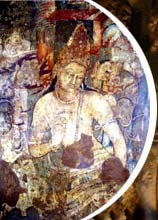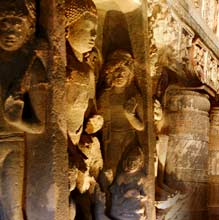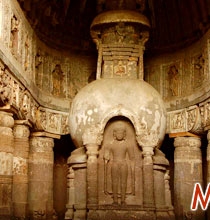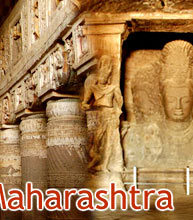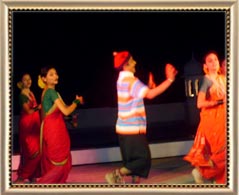 It
is said that dance is one of the best mediums through which you can
express yourself. So, what better way to know about the culture of the
state than through exploring its various dance forms. The people of
Maharashtra celebrate a large number of fairs and festivals and dancing,
as a part of the celebration, is a feature that is common in almost all
of them. Apart from that, there are a number of special occasions, such
as weddings, where dance makes a part of the festivity. In this article,
we have provided information on the most popular folk dances of the
state.
It
is said that dance is one of the best mediums through which you can
express yourself. So, what better way to know about the culture of the
state than through exploring its various dance forms. The people of
Maharashtra celebrate a large number of fairs and festivals and dancing,
as a part of the celebration, is a feature that is common in almost all
of them. Apart from that, there are a number of special occasions, such
as weddings, where dance makes a part of the festivity. In this article,
we have provided information on the most popular folk dances of the
state.Lavni
Lavani comprise of the elements of both, a traditional song and a folk dance. The dance is performed to the beats of 'Dholak', a drum like instrument, mainly by women. It is a wonder how these women, being draped in heavy nine-yard saris, manage to perform the dance movements with such elegance. In the earliest days, the dance form was used to highlight the various aspects of the society like religion, politics, romance, etc. In the 18th and 19th century, it came to be performed to entertain as well as motivate the tired soldiers of Maratha battle. Today, it is performed by people as a part of celebrations.
Dhangari Gaja
Dhangars, the community of shepherds belonging to the Sholapur district of Maharashtra, are known for performing the Dhangari Gaja dance. Since their life mainly revolves around nature and its various forms, their poetry on which the dance is based reflects the same. It is made up of couplets, some of which contain the tales of the birth of their God 'Biruba', and is known as 'Ovi'. The main motive behind the performance of this dance is to appease the Gods. The dancers in Dhangari Gaja are men, wearing Dhoti, Angarakha, Pheta and colorful handkerchiefs, performing to the beats of drums.
Povadas
Povadas is mainly a form of ballad, which revolves around the incidents surrounding the life of the great Maharashtrian leader, Chhatrapati Shivaji Maharaj. The great ruler has always held a reverential position in the hearts of the Marathi people and even through these ballads; they seek to remember the great leader and his glorious life.
Koli
Koli Dance, as the name suggests, is performed by the fishermen of Maharashtra - known as Kolis. Their colorful attire, cheerful personality and distinct identity are very much reflected in their dance form too. The participants of this dance comprise of both men and women, who are divided into two separate groups. One of the most popular movements in the Koli dance is that of the hand, as it moves while rowing a boat. The other movements of the dance include the movements of waves and the casting of nets to catch fish.
Tamasha
Tamasha, the word meaning fun or entertainment, is the name given to the folk theater of Maharashtra. The dance form seems to have been influenced by a number of dance forms. Some scholars also believe it to reflect "Prahsana" and "Bhana" forms of Sanskrit drama. Tamasha is mainly performed on love songs known as 'Lavanis'. The main instruments used for providing betas are Dholki drum, 'Tuntuni' (a single string instrument), 'Manjeera' cymbals, 'Daf' (a tambourine-like instrument), 'Halgi' (smaller Daf), 'Kade' (a metal triangle), 'Lejim' (an instrument with a jangling sound), Harmonium & 'Ghunghroos' (ankle bells).
Dindi
Dindi is another folk dance of Maharashtra, which is performed on the Ekadshi day of the Hindu month of Kartik. The dance is based on Lord Krishna and his naughty, playful nature. It is basically a devotional dance, performed to the beats of Dindi, a small drum. Dancers surround the musicians while performing the dance steps.
Kala
Another dance form that is devoted to Lord Krishna is Kala. It is also based on the mischievous and teasing attitude of the Lord. Dancers also make use of a prop while dancing, which is nothing but a pot. This pot is believed to symbolize fertility. The beat and the rhythm of the Kala dance are what attract viewers to its performance.

